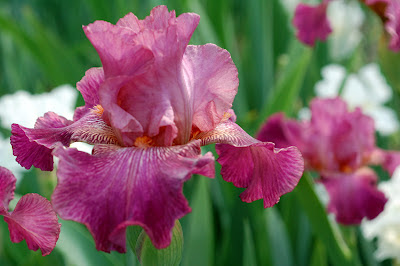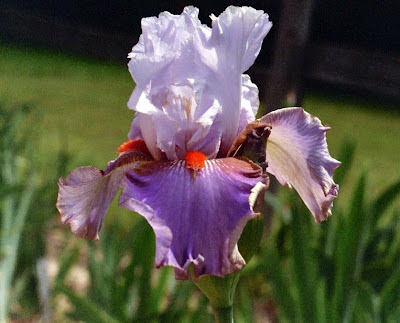By Griff Crump
Several days ago, I asked iris hybridizers and iris lovers to "send me a photo of the flower or flowers that get the most attention in your garden, whether they are recent introductions or not."
So, do our visitors have good taste? Apparently so. Among the 37 registered and/or introduced attention getters are 4 Dykes winners, 4 Wisters, 11 Awards of Merit and 10 Honorable Mentions. 29 of the 37 are award-winning irises.
Sixteen persons responded, including myself, and named 40 different cultivars, the only one to be named twice being 'City Lights'. These include four seedlings, three not yet registered.
That wasn't all that caught my attention, however. Among other things, I found the time periods of introduction of those 37 varieties to be interesting:
1964: 1
1968: 1
1970-1979 3
1980-1989 3
1990-1999 16
2000-2009 10
2010-2012 3
The paucity of favorites in the 2010-2012 2-year period is explainable by the brevity of time involved, but I wonder whether the preponderance of the 1990-1999 time period picks over the 2000-2009 picks is meaningful. It shows a larger number of irises introduced between 12 and 23 years ago to be popular than of those introduced between 4 and 13 years ago. Three of the four Dykes winners fell in the 1990-1999 period; the fourth winner was in 1968. If I'm correct (and I might not be -- someone can check) in supposing that more irises were introduced in the 2000-2009 period than in the previous decade, that would make the difference seem more significant.
It also interests me that no Dykes winners since Silverado in 1994 showed up among these named visitors' favorites.
Will Warner commented, "I didn't have many visitors. But the few I had went right for Louisa's Song, Solar Fire, Decadence, and my Wintry Sky x Mesmerizer seedling. I have noticed after they look at them a while they seem to get somewhat overwhelmed and start to say they like them all or go to their favorite color preference. I start pointing out 'look this one has 12 buds or look at this branching'! But that seems more to the hybridizer's preference, as they just nod and say that's nice, and then point at something else and go oooh look at that one! I have noticed most visitors here don't care much for the dwarfs. They seem to want them big and tall."
Will's observation was followed by Eileen Secrest's: "People are drawn to orange ones, I think because they stand out, like Pumpkin Cheesecake . . . and I think they do exclaim when they see unusual ones like Gypsy Lord, or Decadence, but they don't run across the yard to see those, like they will with the orange ones. Most of the people who come to my garden mostly are surprised at the variety of colors and patterns available. I agree with Will, they do get overwhelmed and sometimes don't appreciate when I point out things like incredible beards or horns. Drives me crazy! :)"
That brings up the fact that there is only space-ager among the named introduced favorites -- Rick Tasco's Solar Fire. Although irisarians like some of the space-agers in my garden, non-irisarian visitors show little interest in them. (One might think that some things like Will Warner's spectacular seedling, shown below, might change that in the future.) And, like Eileen observed, my non-irisarian visitors walk right past some recent Dykes winners (which I won't name -- they don't need any bad press) on their way to 20-year-old flowers that they want to buy.
I noticed something else that I think is remarkable. That is the number of instances in which the hybridizer dipped pretty far back in time (since introduction) to choose the parents of what have turned up as favorites in this survey. Although it may clutter up the text to some degree, I took pains to show the introduction dates of the parents of most of the favorite irises shown here in order to highlight this fact.
One such introduction is Crooked Little Smile, Bob Van Liere's 2008 introduction, for which he reached back to 1982 for one of the parents and to 1992 for the other. The proof is in the pudding. Snow Tree, a 1990 introduction by Robert Sobek, has parents from 1972 and 1979. Linda Mann paired a now 27-year-old iris, Dusky Challenger, with a 1997 introduction to produce her seedling, Dusky Grape. Maryott's 1994 introduction, Cajun Spices, has parentage from the 1970s. Don Spoon's 2010 introduction, Red Hot Mamma, is the offspring of Rogue (1994) and Dynamite (1997). Don also matched his recent (2006) Orchid Dove with a 16-year-older flower, Spring Splendor (1991) to produce Showy Lowy (2011). Niswonger in 1993 introduced Tennessee Vol, resulting from a cross of Countdown (1971) x Marmalade Skies (1978). Finally, Jack Worel in 1999 introduced Rush Creek, from Gentle Dragon (1987) X Rustler (1987).
I don't know how long some of these hybridizers' plants may have sat in their gardens as seedlings before being introduced, but the result is that flowers have been brought into the iris world that people like.
I think one thing that non-irisarian garden visitors are telling us is that "there's gold in them thar hills" of 20-or-so years ago, if we know how to mine it.
So, with that introduction, here are our responders' selections:
Naomi DiVincenzo was first to respond, saying that Crooked Little Smile (Stairway to Heaven [1992] x Satan’s Mistress [1982]) is always the favorite when she takes irises to her workplace.
Crooked Little Smile -- Van Liere, 2008
Lucy Burton's visitors like standard dwarf Snow Tree (Soft Air [1972] X 79S5: (Flapjack [1977] x Baby Toes [1979]) .
Snow Tree -- Robert Sobek, 1990
Linda Mann's standout is her registered seedling Dusky Grape. The cross is Dusky Challenger [1986] X Grape Ice [1997].
Dusky Grape -- Linda Mann, R. 2008
"Everyone went to it first", says Steve Kelly of Shannon Hiatt's seedling blooming in Steve's garden this spring. The cross is Chocolate Ecstasy [2001] X Golden Panther [2000].
Shannon Hiatt seedling
In Valerie Walker's garden, the attention getters are City Lights (Fancy Face [1985] X Windsurfer [1982] ), Strange Brew [various Schreiner seedlings, 1999], Night Ruler [several undated Schreiner seedlings] and Cajun Spices [several Ghio seedlings from late 1970s].
City Lights -- Mary Dunn, 1990
Strange Brew -- Schreiner's, 2002
Night Ruler -- Schreiner's, 1990
Cajun Spices -- Maryott, 1994
Responding as a visitor to a local garden herself, Cathy Dudley was drawn to Silverado (Starina x Navy Strut) X Carriage Trade, [1972, 1972 and 1975, respectively] and Crown Sterling (Henry Shaw x Kingdom) x Good Hope sib) X Honesty, [all prior to 1970].
Silverado -- Schreiner's, 1986
Crown Sterling -- Moldovan, 1974
Colleen Modra reports that Jesse's Song (Charmed Circle x Kiss) X Iris Nelson 34-74A: (Smoke Rings x Decolletage) [all before 1972] is always among the most popular at her garden.
Jesse's Song -- Bryce Williamson, 1979
For Ruth Roberts' visitors, Stepping Out (parentage unknown) is always a popular one, along with Swingtown (Sultry Mood X V 489-2: (1981 #26, unknown, x K400-1: (Cranberry Ice x H
301-B: ((Dream Time sib x Mulberry Wine) x (Skywatch x (Amethyst Flame x
Silvertone))))) [all between 1957 and 1973], World Premier (Yaquina Blue [1992] X 1985 #25, unknown), and Dusky
Challenger (parentage unknown) [1983 seedling] this year.
Stepping Out -- Schreiner's, 1964
Swingtown -- Schreiner's, 1996
World Premier -- Schreiner's, 1998
Dusky Challenger -- Schreiner's, 1986
City Lights also shone in Cheryll Pierce's garden, as well as Rosalie Figge (Titan's Glory [1981] X Violet Miracle [1979]), Daughter of Stars (Clarence [1990] X Mind Reader [1992]), Clarence (parentage unknown [1991]) and Buckwheat (Spirit of Memphis [1976] X Soap Opera [1981]).
Rosalie Figge -- Jane McKnew, 1991
Daughter of Stars -- Donald Spoon, 2000
Clarence -- Zurbrigg, 1990
Buckwheat -- Byers, 1988
Will Warner's visitors focus on Louisa's Song (Cloud Berry [1996] X About Town [1996]), Solar Fire (Thornbird [1988] X Golden Panther [2000]), Decadence (Temple of Time [2001] X Louisa's Song [1999]), his own seedling from Wintry Sky [2002] X Mesmerizer [1990], and Peekaboo Zebu (Anaconda Love [1998] X Screen Play [1995]).
Decadence -- Blyth, 2001
Peekaboo Zebu -- Kasperek, 2005
Ginny Spoon reports that visitors to Winterberry Gardens especially liked Red Hot Mamma (Rogue [1994] X Dynamite [1997]), Showy Lowy (Spring Splendor [1991] X Orchid Dove [2006]) , Zippo (SDB, parentage unknown [2004], Black Cat ( ), Double Ringer (Whispering Spirits [2001] X Amarillo Frills[2002]), Fancy Gal (Dandy Candy [2001] X Favorite Pastime [2000]), and Brilliant Idea (
Gypsy Lord [2005] X 02-185D: (Restless Heart [2005] x Queen’s Circle [1999])).
Gypsy Lord [2005] X 02-185D: (Restless Heart [2005] x Queen’s Circle [1999])).
Red Hot Mamma -- Donald Spoon, 2010
Showy Lowy -- Donald Spoon, 2011
Zippo -- Ginny Spoon, 2011
Double Ringer -- Richard Ernst, 2007
Fancy Gal -- Ernst, 2007
Brilliant Idea -- Keppel, 2009
Double Ringer -- Richard Ernst, 2007
Fancy Gal -- Ernst, 2007
Brilliant Idea -- Keppel, 2009
Eileen Secrest's visitors like Pumpkin Cheesecake (Apricot Frosty [1992] X sib to 26-85: (Ambrosia Delight [1982] x 16-80: (Coral Beauty [1981] x pink amoena Marmalade Skies [1978]sib))), and oranges in general.
Lori Lanford says that most visitors to her garden seem to prefer pinks, such as Magical Encounter (extensive pedigree involving Renaissance Faire [1985] and Dreamsicle [1995]. Many also liked Eastertime, Tennessee Vol (Countdown [1971] x Marmalade Skies [1978]), Carolina Gold, Old Black Magic (Midnight Dancer [1991] X Back in Black [1986]), and various purples. Many said they liked the purples because it reminded them of their mother's or grandmother's irises, but with an updated form.
Lucy Burton said that plicatas get her visitors' attention. That's also true in my garden, where visitors like the whirligig cant of Tale Spinner (Tanzanian Tangerine [1994 ] X 01Z1[2001]: (Royal Carnival x 93R6 (unk yellow bi-tone x Stepping Out)). Other standouts are Jack Worel's stunning Rush Creek (Gentle Dragon [1987] X Rustler [1987] and an older bold yellow seedling of mine, 952Z1, that I'm going to introduce just so I won't have to keep saying "sorry" to would-be buyers.
Pumpkin Cheesecake -- Niswonger, 1995
In Nicolette Mealey's garden, the attention-getters are Rustler (Laredo [1983] X Dazzling Gold [1977]) and Tiger Honey (Desert Realm [1985] X Maria Tormena [1986].
Rustler -- Keppel, 1987
Tiger Honey -- Kasperek, 1993
Lori Lanford says that most visitors to her garden seem to prefer pinks, such as Magical Encounter (extensive pedigree involving Renaissance Faire [1985] and Dreamsicle [1995]. Many also liked Eastertime, Tennessee Vol (Countdown [1971] x Marmalade Skies [1978]), Carolina Gold, Old Black Magic (Midnight Dancer [1991] X Back in Black [1986]), and various purples. Many said they liked the purples because it reminded them of their mother's or grandmother's irises, but with an updated form.
Magical Encounter -- Schreiner's, 1999
Tennessee Vol -- Niswonger, 1993
Carolina Gold -- Powell, 1970
Old Black Magic -- Schreiner's, 1996
Lucy Burton said that plicatas get her visitors' attention. That's also true in my garden, where visitors like the whirligig cant of Tale Spinner (Tanzanian Tangerine [1994 ] X 01Z1[2001]: (Royal Carnival x 93R6 (unk yellow bi-tone x Stepping Out)). Other standouts are Jack Worel's stunning Rush Creek (Gentle Dragon [1987] X Rustler [1987] and an older bold yellow seedling of mine, 952Z1, that I'm going to introduce just so I won't have to keep saying "sorry" to would-be buyers.
Tale Spinner -- Crump, 2012
Rush Creek -- Worel, 1999
Sdlg 952Z1 -- Crump
Thanks to all of you who sent me photos of your visitors' favorites, and thanks also to the contributors to our AIS TWiki, from which most of the rest of these photos have been cadged. Which irises are visitors to your garden most drawn to? Do you find that certain colors attract attention?

















































